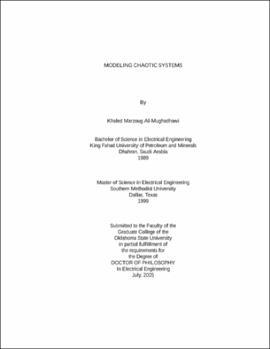| dc.contributor.advisor | Hagan, Martin T. | |
| dc.contributor.author | Al-Mughadhawi, Khaled Marzoug | |
| dc.date.accessioned | 2013-12-10T18:05:42Z | |
| dc.date.available | 2013-12-10T18:05:42Z | |
| dc.date.issued | 2005-07 | |
| dc.identifier.uri | https://hdl.handle.net/11244/7842 | |
| dc.description.abstract | Scope and Method of Study: The purpose of this research is to model chaotic systems. From a set of scalar measurements taken from a chaotic system, we want to describe the hidden states of the system. The modeling process has two parts: determining the model order, and determining the model parameters. The major characteristic of chaotic systems is their sensitivity to changes in initial conditions. This characteristic limits the ability to make a long term prediction in these systems. To be able to make an accurate model, we need to accurately estimates of the model parameters, which requires an accurate estimate of the model order. | |
| dc.description.abstract | Findings and Conclusions: In this research we found four new algorithms to estimate the model order. These algorithms were tested on different chaotic systems. Three of these algorithms are geometric and one is predictive. We checked on the ability of these algorithms to make accurate estimates of the model order. We also proved a new theorem that relates the Lyapunov exponents (model parameters) to the linear system poles. We introduced a new algorithm that implement the result of this theorem to estimate the model parameters of a chaotic model. Beside this algorithm, we improved an existing algorithm that uses a neural network to estimate the model parameters. Both algorithms were tested on different chaotic systems. Our finding with respect to the algorithms used to estimate the model order can be summarized in the following: i) the predictive algorithm gave the best estimate of model order as long as the signal to noise ratio is not too low, ii) the global neighbor search algorithms proposed in this research gave better estimate of model order than the local neighbor search algorithms, iii) the use of more than one algorithm to estimate model order increases our confidence in the estimated value. With respect to the algorithms used to estimate the model parameters, the main conclusions are: i) the predictive algorithm gives good estimate of the model parameters for signals with high signal to noise ratio, ii) the algorithm that implement the new theorem result gives good estimate of the model parameters in some cases, and iii) when using more than one algorithm to estimate the model parameters, one can have confidence in the estimate values if they are in agreement with each other. | |
| dc.format | application/pdf | |
| dc.language | en_US | |
| dc.rights | Copyright is held by the author who has granted the Oklahoma State University Library the non-exclusive right to share this material in its institutional repository. Contact Digital Library Services at lib-dls@okstate.edu or 405-744-9161 for the permission policy on the use, reproduction or distribution of this material. | |
| dc.title | Modeling chaotic systems | |
| dc.contributor.committeeMember | Young, Gary E. | |
| dc.contributor.committeeMember | Yarlagadda, Radha K. Rao | |
| dc.contributor.committeeMember | Latino, Carl D. | |
| osu.filename | Al-Mughadhawi_okstate_0664D_2167.pdf | |
| osu.accesstype | Open Access | |
| dc.type.genre | Dissertation | |
| dc.type.material | Text | |
| thesis.degree.discipline | Electrical and Computer Engineering | |
| thesis.degree.grantor | Oklahoma State University | |
